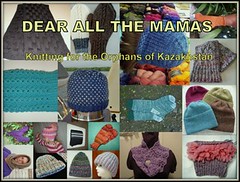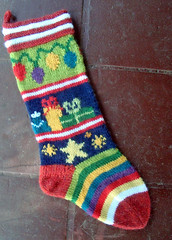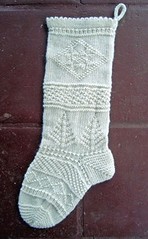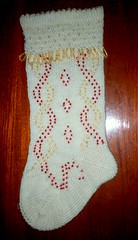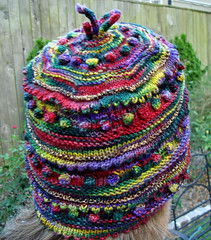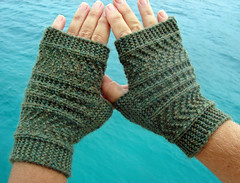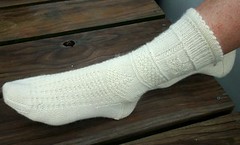
Thursday, October 27, 2011
Mayan Deer Dance Festival
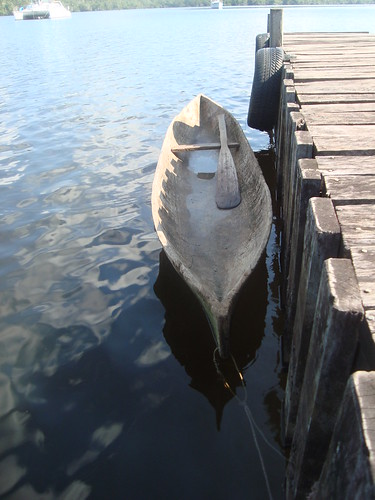 It's a long, hot summer here in the Caribbean coastal area of Guatemala. The oppressive heat and high humidity make the simple act of walking seem like a marathon run. But there are always interesting things to see and events to go-see-do that drag us off our boats to seek adventure.
It's a long, hot summer here in the Caribbean coastal area of Guatemala. The oppressive heat and high humidity make the simple act of walking seem like a marathon run. But there are always interesting things to see and events to go-see-do that drag us off our boats to seek adventure.Down river from us is a biological reserve called the Biotopo Chocon Machacas to protect the Caribbean manatee and other jungle native wildlife. Within this area is also a school for the indigenous Q'eqchi' Mayan children, a small rustic hotel and restaurant. The local people were putting on a presentation of the traditional "Mayan Deer Dance" not only for their own enjoyment, but also as a fundraiser for the school.
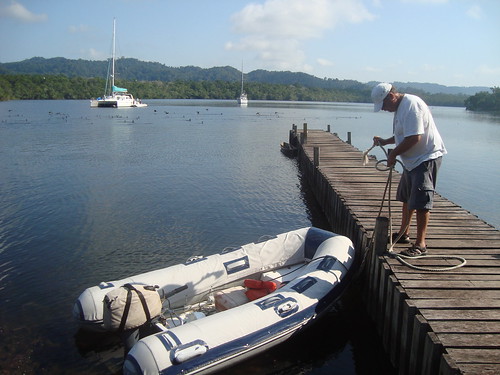
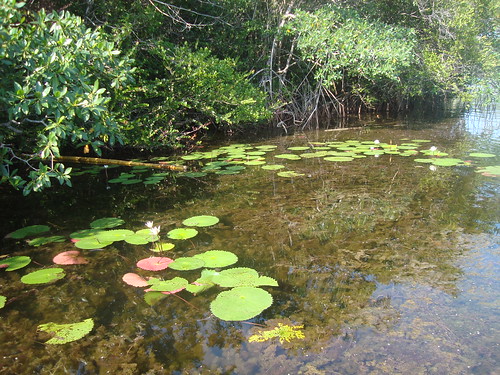 So off we went! We threw off the dock lines, and headed down river in our boats. There are no "road signs" on the river so thankfully a cruiser who had been there before guided us all into the isolated, calm lagoon (Lagunita Salvador (15.47’ .00 North, 88.50’ .51 west for you google earth folks) and dropped our anchor. All around us we could hear and see the large flocks of water fowl and land-based critters. I sure wish we could have just anchored in this place for many days because it was so serene and natural. But, this is a lawless locale and it is not recommended to be out here alone. There is just too much poverty and what little we have can bring great wealth to a man who struggles to feed his family. So we had a little group of us for safety.
So off we went! We threw off the dock lines, and headed down river in our boats. There are no "road signs" on the river so thankfully a cruiser who had been there before guided us all into the isolated, calm lagoon (Lagunita Salvador (15.47’ .00 North, 88.50’ .51 west for you google earth folks) and dropped our anchor. All around us we could hear and see the large flocks of water fowl and land-based critters. I sure wish we could have just anchored in this place for many days because it was so serene and natural. But, this is a lawless locale and it is not recommended to be out here alone. There is just too much poverty and what little we have can bring great wealth to a man who struggles to feed his family. So we had a little group of us for safety.Soon enough we dinghy'd to the dock, tied up, and walked along the wooden boardwalk through the jungle to the facilities.

The older children had decorated the "Welcome" arches across the walkway with festive balloons and were anxiously awaiting us. Once we had paid our donation and pocketed our little slip of paper which was our meal ticket, we were free to explore the site before the performance. My head kept spinning around to study the beautiful huipiles (blouses) of this village.
 Down here in the low altitude (hot) eastern Caribbean side of Guatemala, the women wear lace huipiles often with elaborate embroidery. Most of the lace is machine made, and often so is the embroidery. But I do see some crochet lace, and handmade embroidery if I look closely. Underneath the huipile they wear a simple single colored camisole.
Down here in the low altitude (hot) eastern Caribbean side of Guatemala, the women wear lace huipiles often with elaborate embroidery. Most of the lace is machine made, and often so is the embroidery. But I do see some crochet lace, and handmade embroidery if I look closely. Underneath the huipile they wear a simple single colored camisole. 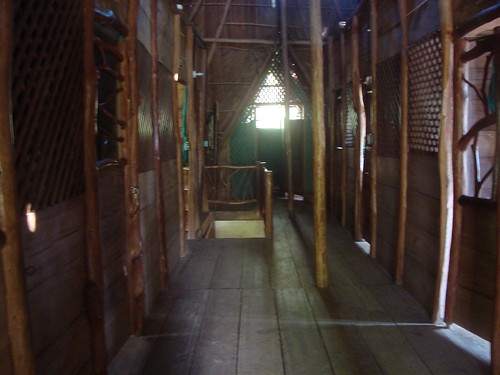
The gathered skirt is also worn as everyday wear. I would love to be able to wear such beautiful clothing! But that would probably be insulting to the Mayans (won't stop me from buying some though 'cause they sell all of this locally). And yet, at the same time I am thankful for all the strong women in the world who have fought for us (albeit not all of us yet) to be able to wear more comfortable clothing of our choice. I'm still wanting to be able to go shirtless at the beach like a man though. Let's do it in my lifetime, OK? (stepping off soap box now)

The eco-lodge is a beautiful 2-story structure made from locally sourced natural materials for the most part. This view is the upstairs hallway with doors leading to the dorm (hotel) rooms off both sides. I loved (and of course had to gently stroke) the decorative and functional privacy screening made from bark-striped branches in their naturally shaped form. The whole building is open and airy to let the breezes through (no air-conditioning).
Peeking inside the rooms, we find your basic necessities of wood furniture, bedding, and mosquito netting all under the palm-thatched roof. Really, what more could you want out here?
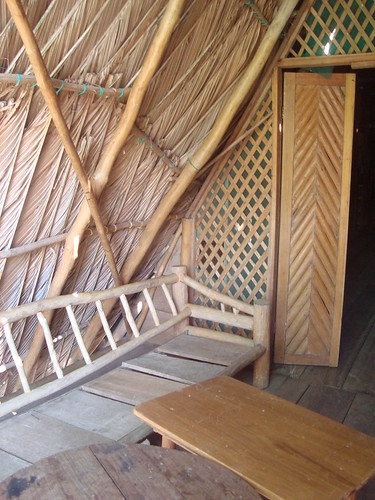 For lounging, there is a nice open-ended rustic sitting room at one end of the lodgings. Can you see yourself reclined here with a cold fruit beverage, immersed in a good book, bird watching (or listening) and knitting? Or taking a stroll down to the lagoon to try and spot a manatee coming up for air while thunderheads rise over the mountains to the south?
For lounging, there is a nice open-ended rustic sitting room at one end of the lodgings. Can you see yourself reclined here with a cold fruit beverage, immersed in a good book, bird watching (or listening) and knitting? Or taking a stroll down to the lagoon to try and spot a manatee coming up for air while thunderheads rise over the mountains to the south?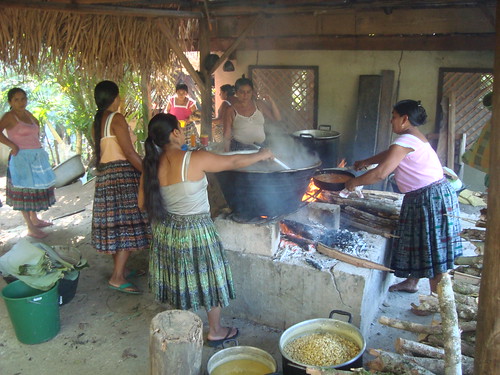 Back outside, we stopped to watch the women preparing the feast. The preparation of meals in rural Guatemala is a long, hot and tedious process.
Back outside, we stopped to watch the women preparing the feast. The preparation of meals in rural Guatemala is a long, hot and tedious process.First, the corn must be ground into a fine meal before mixing with water to make the tortillas and/or tamales. The dried rice needs to be cooked, and the fowl (turkey in this case) must be slaughtered, water fetched, fires started and tended, and root vegetables harvested, peeled and cut.
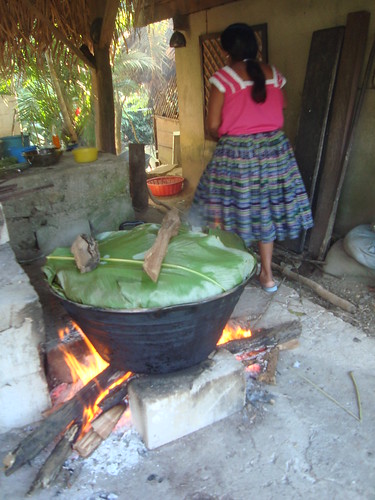
What's in this big kettle underneath the banana leaves? Tamales! The women have made these by putting a handful of corn dough (masa) into a piece of banana leaf, then folded and wrapped the leave securely around the dough. These then are all placed together in a kettle with water and steamed for a long time to cook the dough.
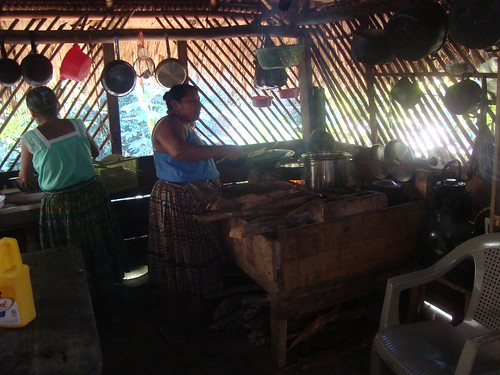
These ladies are working in the more modern kitchen complete with running water. We assume that this is the kitchen where meals are normally made for hotel guests, while the big kettles are for large gatherings such as this festival. I noticed that they remove their lace huipiles when cooking. They always wear them when in town shopping, and they put them back on later.
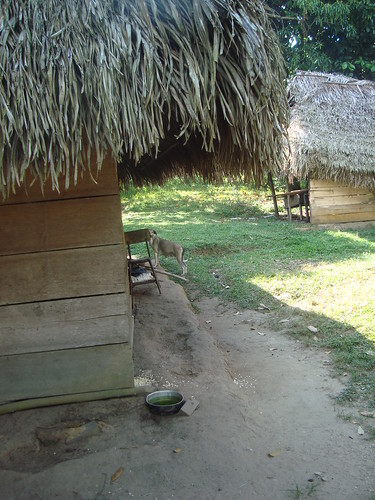
We were quite impressed by the tidiness of the village houses. They palm-thatched single room houses did have wood siding which is an upgrade from the adobe mud that we've seen elsewhere too. Of course there was the medium-sized family dog wandering about.

Ah ha! The mirimba (Guatemala Xylophone) has been set up and everyone is eager for the show to begin. People emerge from the surrounding areas and line the grass field; women in their colorful clothing, children squirming, and men in western wear. The Mayan Deer Dance is a traditional show where the actors wear brightly colored and highly decorated costumes while sharing the story of the Conquistadors arrival.
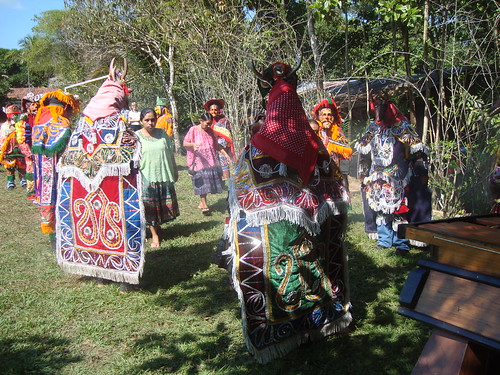
Actually, the tale is a satire and pokes fun at the Spaniards who kill off all the deer, jaguars and destroy the balance of nature. At the end, after also killing off the Mayan people, all that is left are the foolish Spaniards. It is said that when this dance was performed for the Spaniards, they mistakenly thought it was a tribute to their conquest! Hence the joke was on them.
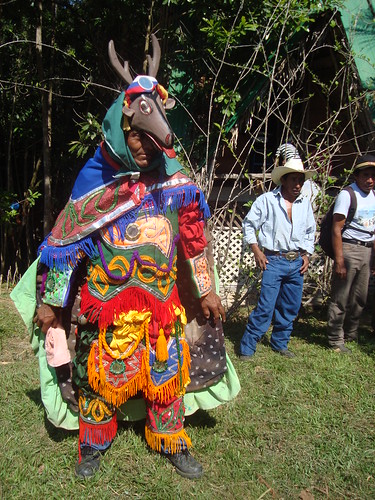
Before the dance can begin, women offer a blessing to the players with burning incense. Then let the show begin! No, we couldn't follow all of it, but it was fun just to watch the dancers flounce about. At times, the audience would gasp or laugh in reaction to the story. Obviously, they all knew what was happening!
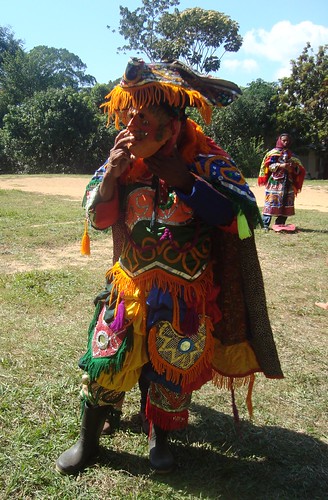
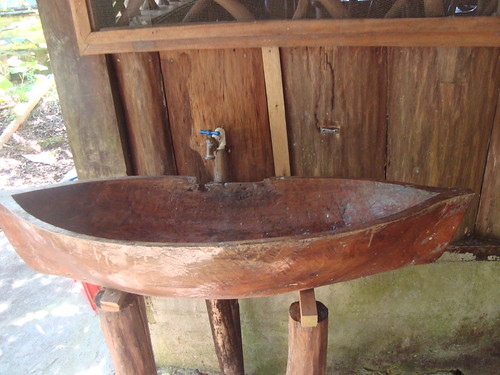
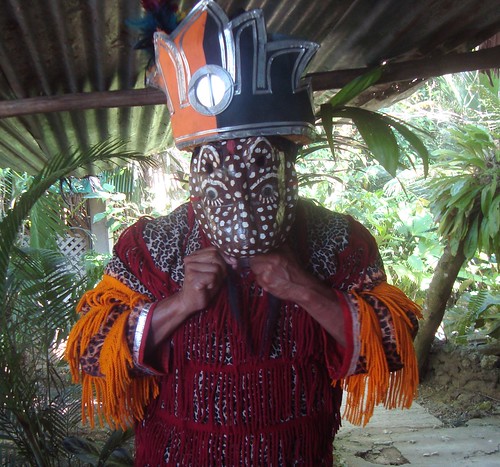
 So, let's see...here's one of the deer, and one of the Conquistadors. You can tell by the masks. One of these must be the jaguar, oh here it is. Oh, it was just too hard to tell at times. The costumes were so elaborate and we were sitting some distance away. These dancers really went all out with their pantomimes; running around in the heat in these heavy costumes and full facial masks. During the intermission, we were able to see some of the costumes up close. The rental of these costumes is quite expensive and this festival doesn't happen every year in a particular village, but moves about the area.
So, let's see...here's one of the deer, and one of the Conquistadors. You can tell by the masks. One of these must be the jaguar, oh here it is. Oh, it was just too hard to tell at times. The costumes were so elaborate and we were sitting some distance away. These dancers really went all out with their pantomimes; running around in the heat in these heavy costumes and full facial masks. During the intermission, we were able to see some of the costumes up close. The rental of these costumes is quite expensive and this festival doesn't happen every year in a particular village, but moves about the area.When the conquistadors had finally killed off everything that was living and were alone in the "new world" the dance ended. Now, it was time to eat! Check out this great little outdoors sink where the basin is a miniature cayuca (dug out canoe).
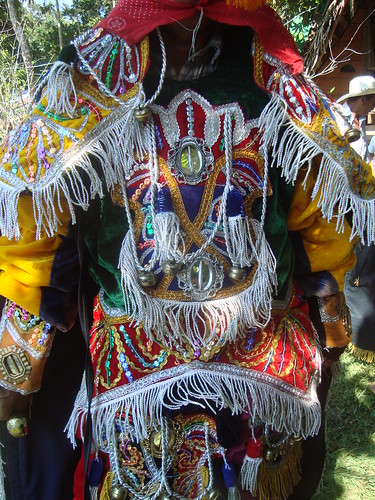
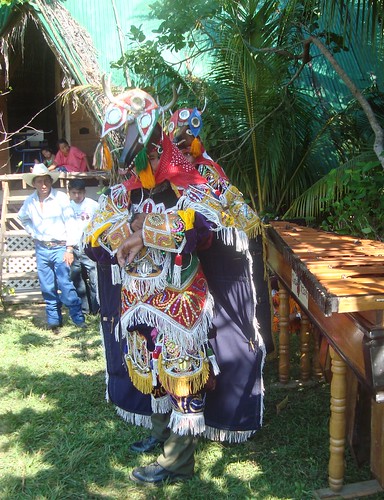
Those of us who were visitors and paying guests were treated to our meals inside the dining room of the hotel. Also, some of the villager men ate inside, while the women and children ate their meals outside. We were brought our large bowls of steaming hot soup as the main course - complete with a whole turkey leg or thigh in it! These were your smaller turkeys so don't imagine the size of the drumsticks you see in your American or Canadian homes for Thanksgiving.
The tamales were a bit of a disappointment...no flavor nor filling of any kind. They were just fist sized balls of corn dough. I ended up slicing pieces of my tamale into my soup. I later saw that many of the women were sitting on the grass chatting and nibbling their tamales by taking pinches of the dough with their fingers and putting it in their mouths. They seemed to really be enjoying it too. Much as I love corn, I just can eat that much plain corn dough at one sitting.
Also in our soups was 1/2 of a potato and about 1/2 of a choyote squash (about the size of a large pear), and some sort of leafy herb floating about. Boiled rice was served on the side. The broth was quite tasty. So we chewed through our rubber turkey and enjoyed the company of other people and our surroundings.
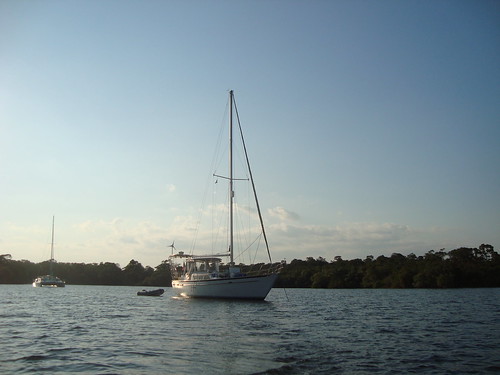 Now the beverage was very special! The local village grow cacao trees and process the chocolate from the beans. Pure, unadulterated Guatemalan chocolate is the finest type of chocolate in the world. We were served the ancient chocolate beverage of the Mayans - cold water chocolate. For modern tastes they did add sugar. I really liked it and drank not only mine but some other folks' as well. I was a very lucky gal indeed.
Now the beverage was very special! The local village grow cacao trees and process the chocolate from the beans. Pure, unadulterated Guatemalan chocolate is the finest type of chocolate in the world. We were served the ancient chocolate beverage of the Mayans - cold water chocolate. For modern tastes they did add sugar. I really liked it and drank not only mine but some other folks' as well. I was a very lucky gal indeed.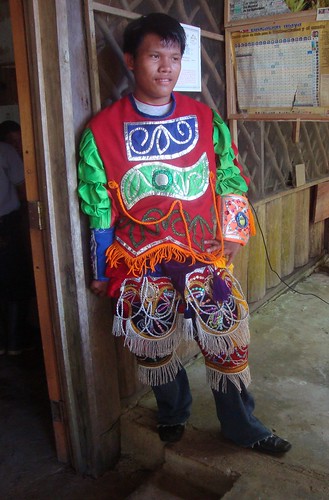
By late afternoon, we were full of our typical Mayan festival meal and were ready to head to a safe anchorage for the night and new adventures to come.
Thank you to all the dancers, organizers, cooks, cleaning crews, decorators and everyone else who contributed to making the Mayan Deer Dance such an interesting event.
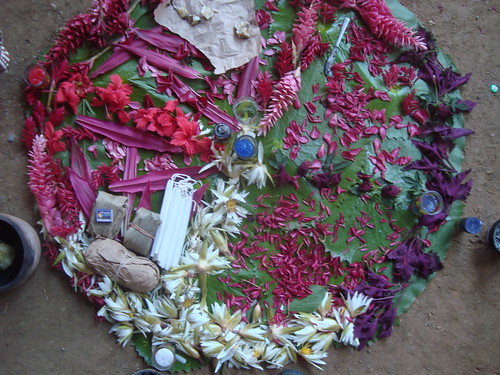 |
| Mayan Blessings |
Comments:
<< Home
Leave to the 'civilized' to ruin the whole ecology of a place. I've seen parts of the deer dance at one of our Hispanic Cultural Events here. When you said they gasped and cheered at certain parts of the performance like they knew the story, it reminded me of the Kindergarten Thanksgiving play that is performed here at our school every year. The audience is made up of all the older students so of course they remember all the parts to the play from when they were in Kindergarten. The older kids will quietly say certain lines or act out certain parts with the performers. It's cute. Tradition, ain't great!?
Helllllllo out there.... I am always amazed what you find and the experiences you have. This sounded awesome and the pictures are great. wow!!! so much to take in. This adventure was great, keep them coming....... but be careful too.
Your adventures are always fascinating. We were Puget Sound power boaters but had world-traveling sailor friends so can relate to your stories through them. We did live aboard for a few years and loved every minute of it until an Arctic express storm drove us ashore. Keep the stories coming.
Hi Niki Wiki,
What a great adventure in Guatemala. Fabulous pictures and descriptions. Wish we could have been there. "Pelican" is on the Rio, but we are in NC. We will be coming back in early January. Hope to see you on the water.
Kathryn
What a great adventure in Guatemala. Fabulous pictures and descriptions. Wish we could have been there. "Pelican" is on the Rio, but we are in NC. We will be coming back in early January. Hope to see you on the water.
Kathryn
We're just watching a program on tv called Dave gormans googlewhack adventure in the uk and decided to see if we could find one ourselves. We put in Sailknotters hang and it brought up just your website!!!
You are a googlewhack!!!
Post a Comment
You are a googlewhack!!!
<< Home



